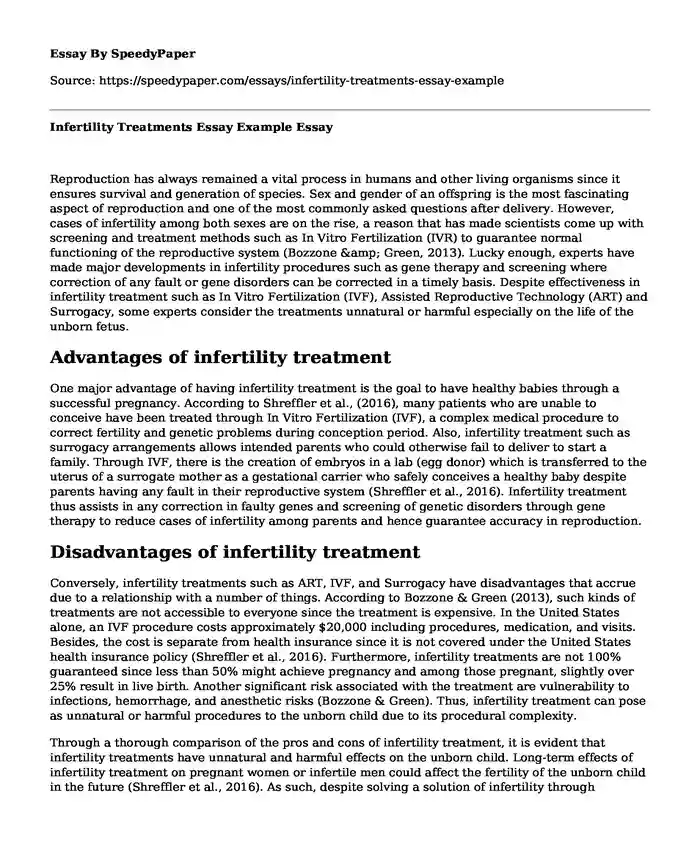Reproduction has always remained a vital process in humans and other living organisms since it ensures survival and generation of species. Sex and gender of an offspring is the most fascinating aspect of reproduction and one of the most commonly asked questions after delivery. However, cases of infertility among both sexes are on the rise, a reason that has made scientists come up with screening and treatment methods such as In Vitro Fertilization (IVR) to guarantee normal functioning of the reproductive system (Bozzone & Green, 2013). Lucky enough, experts have made major developments in infertility procedures such as gene therapy and screening where correction of any fault or gene disorders can be corrected in a timely basis. Despite effectiveness in infertility treatment such as In Vitro Fertilization (IVF), Assisted Reproductive Technology (ART) and Surrogacy, some experts consider the treatments unnatural or harmful especially on the life of the unborn fetus.
Advantages of infertility treatment
One major advantage of having infertility treatment is the goal to have healthy babies through a successful pregnancy. According to Shreffler et al., (2016), many patients who are unable to conceive have been treated through In Vitro Fertilization (IVF), a complex medical procedure to correct fertility and genetic problems during conception period. Also, infertility treatment such as surrogacy arrangements allows intended parents who could otherwise fail to deliver to start a family. Through IVF, there is the creation of embryos in a lab (egg donor) which is transferred to the uterus of a surrogate mother as a gestational carrier who safely conceives a healthy baby despite parents having any fault in their reproductive system (Shreffler et al., 2016). Infertility treatment thus assists in any correction in faulty genes and screening of genetic disorders through gene therapy to reduce cases of infertility among parents and hence guarantee accuracy in reproduction.
Disadvantages of infertility treatment
Conversely, infertility treatments such as ART, IVF, and Surrogacy have disadvantages that accrue due to a relationship with a number of things. According to Bozzone & Green (2013), such kinds of treatments are not accessible to everyone since the treatment is expensive. In the United States alone, an IVF procedure costs approximately $20,000 including procedures, medication, and visits. Besides, the cost is separate from health insurance since it is not covered under the United States health insurance policy (Shreffler et al., 2016). Furthermore, infertility treatments are not 100% guaranteed since less than 50% might achieve pregnancy and among those pregnant, slightly over 25% result in live birth. Another significant risk associated with the treatment are vulnerability to infections, hemorrhage, and anesthetic risks (Bozzone & Green). Thus, infertility treatment can pose as unnatural or harmful procedures to the unborn child due to its procedural complexity.
Through a thorough comparison of the pros and cons of infertility treatment, it is evident that infertility treatments have unnatural and harmful effects on the unborn child. Long-term effects of infertility treatment on pregnant women or infertile men could affect the fertility of the unborn child in the future (Shreffler et al., 2016). As such, despite solving a solution of infertility through Intrauterine Insemination, Artificial Insemination, and IVF, the human tissues specifically the eggs or sperms might be exposed to an unnatural procedure that distorts its normal functioning at a particular time in its life cycle. While many parents live through a stressful time of infertility, infertility treatments in many cases lead to the risk of multiple pregnancies from injectable fertility drugs (Shreffler et al., 2016). Increased cases of unhealthy twins or triplets have been reported in hospitals which have seen a female parent unable to cope with the burden of multiple pregnancies during reproduction.
Conclusion
Male and female infertility, without doubt, continues to remain on the rise in a world where factors that increase infertility continue to pose danger among couples. With various infertility treatments developed by experts, risks associated with infertility treatment are extensive. Procedures such as gene therapy, Surrogacy, In Vitro Fertility, Artificial Insemination, Intrauterine Insemination, and Assisted Reproductive Technology (ART) expose unborn children to unnatural and harmful conditions. These conditions result in adversative effects which could be avoided in normal reproduction. However, with right ethical considerations in research and medical profession, infertility treatment can be handled safely and effectively.
References
Bozzone D.M. & Green D. S., (2013). Biology for the Informed Citizen: With Physiology. Oxford University Press. Pp. 172-184
Shreffler, K., Tiemeyer, S., Dorius, C., Spierling, T., Greil, A., & McQuillan, J. (2016). Infertility and fertility intentions, desires, and outcomes among US women. Demographic Research, 35, 1149-1168. Retrieved from http://www.jstor.org/stable/26332107
Cite this page
Infertility Treatments Essay Example. (2022, Jul 08). Retrieved from https://speedypaper.net/essays/infertility-treatments-essay-example
Request Removal
If you are the original author of this essay and no longer wish to have it published on the SpeedyPaper website, please click below to request its removal:
- Free Essay Sample on Cultural Issues of Americans, Germans, and Japanese
- Essay Example on Criticism about The Aged Mother
- Literary Essay Sample on Arthur Koestler's Darkness at Noon
- Essay Example: The Environmental Costs and Benefits of Fracking
- Inter-Organizational Collaboration - Free Essay for Your Inspiration
- Essay Sample: Youth Service Bureau and Its Impact to Society
- Essay Example: The New Volunteer Workforce
Popular categories





